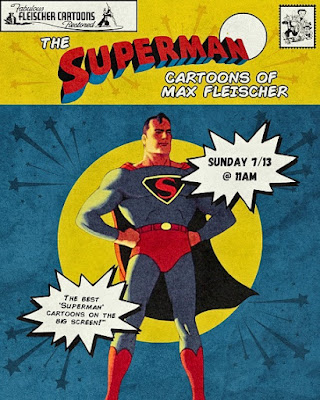He can “leap tall buildings in a single bound,” because the flying business was not yet fully established in the comic books when Fleischer Studios first animated Superman. Some of his greatest enemies are absent for the same reason. However, animation allowed them to depict the Man of Steel battling more powerful foes than the early 1950s TV series could ever hope to realize. Consequently, the Fleischer shorts (Produced by Max and directed by Dave) greatly shaped the development of the Superman franchise in ways that remain evident today. The Fleischer Superman shorts might even be the best Superman films screening this week in theaters when a selection of five shorts starts playing tomorrow at the Museum of the Moving Image and the entire restored Fleischer run screens Sunday at the Culver Theater.
In the Oscar-nominated Superman, we learn Clark Kent grew up in an orphanage rather than with Jonathan and Martha, so what alternate Earth does that make this? Regardless, the eponymously titled film quickly establishes the recurring theme of technology running amuck when a mad scientist tries to extort Metropolis with his electrothansia ray. Of course, Los Lane blunders into his lair first, so Superman must rescue her while saving the city. For the time, this was eye-popping stuff, rendered in exotic color. The art deco design continues to influence the look of the franchise, especially Superman: The Animated Series.
Mad scientists continue to conduct themselves in a dangerous and anti-social manner in The Mechanical Monsters. This time, an evil genius dispatches his platoon of robots on a crime spree throughout Metropolis. By contemporary standards, the 9 to 10 minutes Fleischer shorts tell relatively simple stories, but it is hard to get much more satisfying than watching Superman smash an army of robots.
It is fortunate Superman is “more powerful than a locomotive,” because he must corral a runaway train in Billion Dollar Limited. The train in question is a gold bullion shipment to the U.S. Mint. Although Superman’s adversaries are entirely human, he must perform feats of strength that would not be possible for George Reeves.
The Arctic Giant is an absolute Superman classic. It is also a kaiju movie that predates the original Japanese Godzilla by twelve years. Through negligence and Lois lane’s distraction, a dinosaur frozen in ice thaws out, allowing it to rampage through Metropolis. Frankly, the dino-kaiju is kind of cute, but that is part of the film’s charm, Regardless, even the Salkind films could not have credibly created this kind of spectacle.
Maybe in a way, The Bulleteers is a forerunner to mecha/armored supervillainy, because the titular bad guys use their bullet car (which is very Batmobile-esque) to torpedo banks and extort the city. Again, Superman wraps things up pretty quickly, because the Flesichers were limited to one reel, but the Bulleteers leave an impressive swath of destruction in their wake.
The Magnetic Telescope once again leads viewers to ask, “science, what is it good for?” In this case, a crackpot professor uses said gizmo to draw a comet closer to Earth, for his detailed observations. Yet, ironically, it is the fear and over-reaction of the authorities that nearly leads to Armageddon. Even if he cannot fully “fly” yet, Superman must engage in some planetary-level heroics.
Electric Earthquake might be in danger of cancellation, because it depicts a Native American scientist, who invents a seismic disruptor ray, to take back possession of New York City for his people. Suddenly, Superman is a New Yorker, so maybe this is yet another Earth. Regardless, defenders argue the Indigenous scientist is portrayed in a respectful manner (including the authoritative voice of series narrator, Jackson Beck), which is true. Arguably, Electric Earthquake represents an early cautionary examination of legitimate grievances festering into extremism and violence.
Volcano is another example of the big earth-shaking spectacles that wouldn’t be possible for decades in live action—and were ground-breaking in the Fleischer animation. Conversely, it keenly illustrates the lack of chemistry between Lane and Kent at this stage of the franchise history. Throughout the Fleischer films, she frequently stabs Kent in the back professionally, but he keeps saving her in his Superman persona. Nevertheless, Volcano proves you can have a cool-looking Superman story, without super-villains.
Finally, Terror on the Midway is another true Superman classic, pitting the Man of Steel against Gigantic, an enormous gorilla accidentally let loose by a mischievous monkey, who also ignites a fire inside the big top. This is vintage primate madness, produced seven years before The Mighty Joe Young and only nine years after King Kong. True fans might also see echoes in Superman’s longtime nemesis, Gorilla Grodd, whose comic debut came in 1959.
All the Fleischer Studios Superman films are fun and snappy. Even when you binge all nine, they never feel repetitive. The voice cast does not exactly interpret their characters like we expect in contemporary animated films, but they all sound character appropriate. Indeed, Bud Collyer, Joan Alexander, and Jackson Beck all reprises their roles from the radio show, as Superman/Kent, Lane, and the announcer, respectively. Consequently, the Flesicher films represent cinema history that every animation and DC fan should see. Very highly recommended, all nine screen at the Culver this Sunday (7/13) and Mechanical Monsters, Bulleteers, Arctic Giant, Terror on the Midway, and Billion Dollar Limited screen at MoMI tomorrow (7/10) through October 12.


